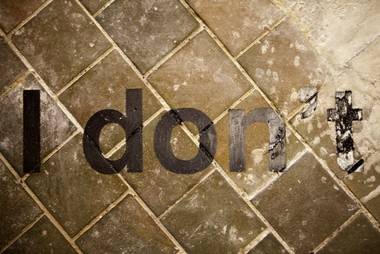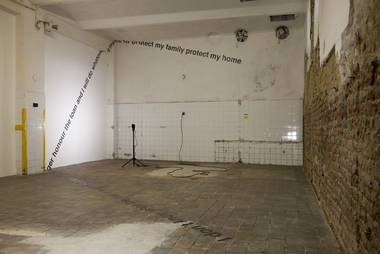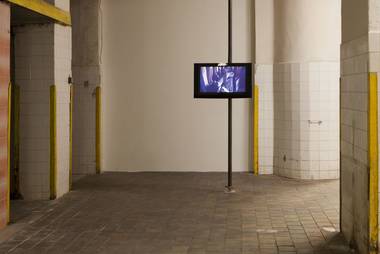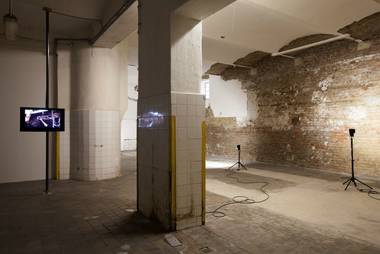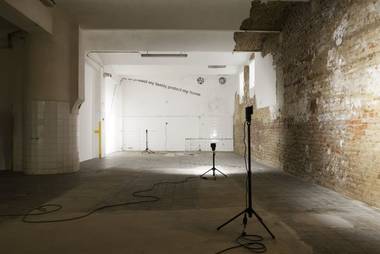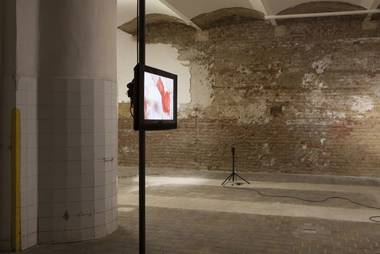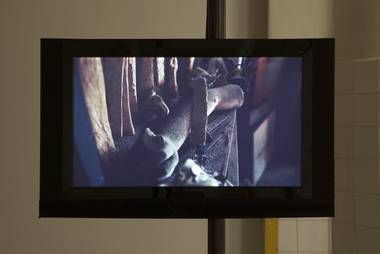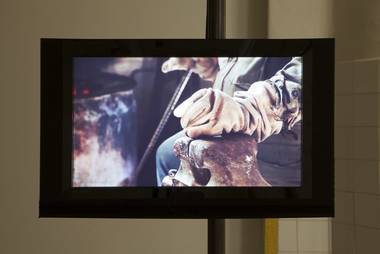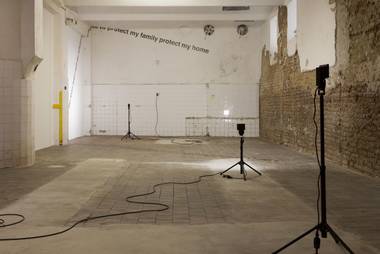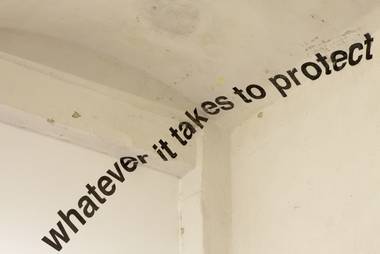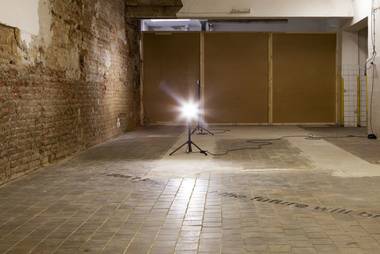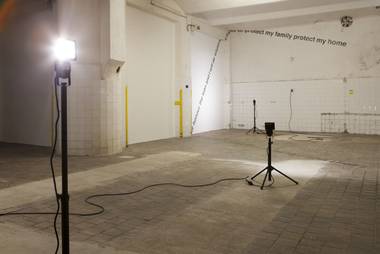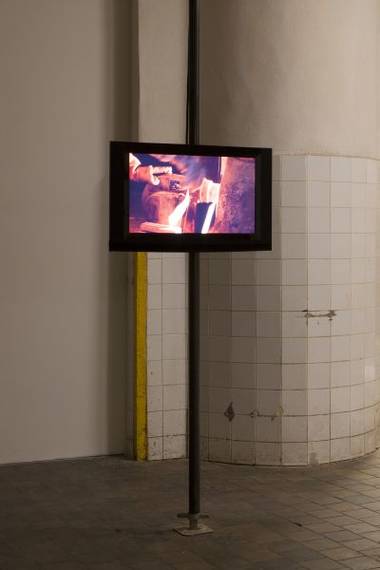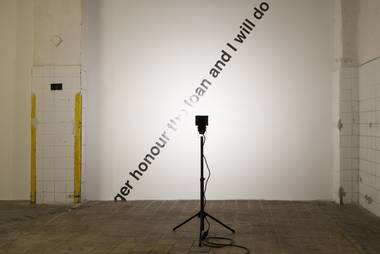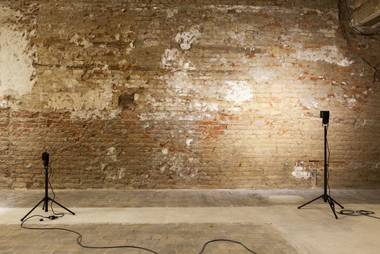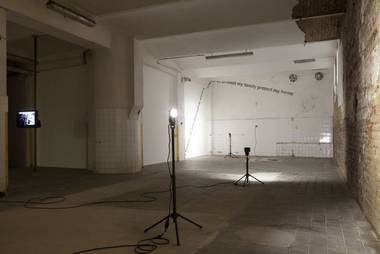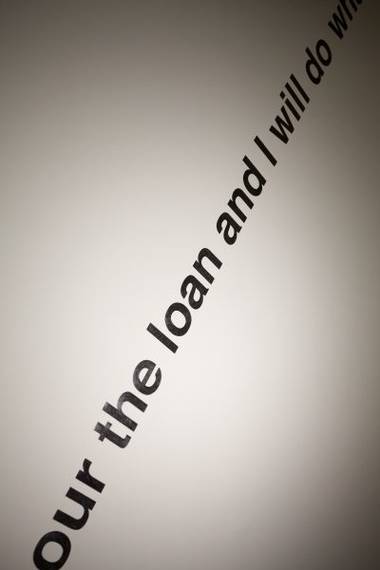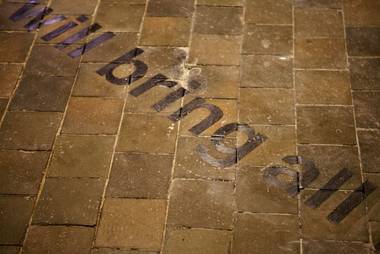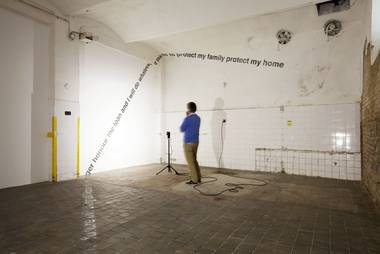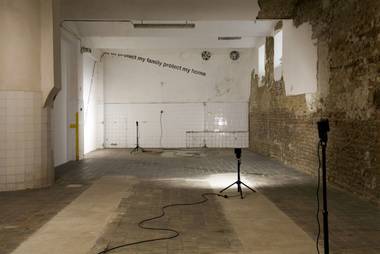Antonis Pittas: merget in cycle
18. 5. – 29. 6. 2016
opening: 17. 5. 2016
curator: Jen Kratochvíl
The legend of Orpheus
is well-known.
In Greek mythology, Orpheus was
a troubadour from Thrace.
He charmed even the animals.
His songs diverted his attention
from his wife Eurydice.
Death took her away from him.
He descended
to the netherworld,
and used his charm
to win permission
to return with Eurydice
to the world of the living
on the condition
that he never look at her.
But he looked at her
and was torn away from her
by the Bacchantes.
Where does our story
take place...
and when?
A legend is entitled to be
beyond time and place.
Interpret it as you wish...¹
“Greece’s economic crisis goes on, like an odyssey without end. Last year was deeply tumultuous for the troubled country but with growing fears of social unrest, 2016 could be even more unpredictable when Stavros Staikos thinks of the year ahead, he expresses…”²
Athens 2004, Olympic stadium, motto: “Welcome home”, return of the leading international sports competition to the environment of its conception. Locality transformed by the infrastructure of the monstrous institution. Workshop for bronze casting. Severed from the time line. Male sculpture with an outstretched arm in the Ancient Greek gesture symbolising power and art, bonded by higher intellectual qualities. Melting metal. Waste material. Snipping, old tools, metal remnants and fragments of damaged original bronze sculptures. Heat materialised on the sweating hands of the molders.
Whole "Olympic village" created a new gentrified part of town around itself. Workshop remains at the time when Pittas is shooting his short video “untitled” in 2015 as one of the last witnesses of the original character of this environment. It probably exists no more.
Individual layers of time meet at the moment of creation of new objects for an exhibition of Pittas. The tradition of bronze casting doesn’t have any usability anymore. We can hardly take into account local small businesses in the time of a multiple economic crisis. Original found material is melted and reused to create commodities for global presentation of art and needs of the art market in theatrical reference to the long lost past.
Former bakery, neutral industrial character, deprived of its original function and thus commutable among countless other similar transfers of an original purpose into exhibition spaces. Battered walls revealing bricks, tiles on the floor moving away from inserted concrete strips. Every factory is a museum now.
The Guardian is constantly reporting on the economical situation in Greece, old Prague bakery is in relative safety.
Few pairs of hands are gradually turning silver, fine muscles in fingers and wrists are slowly ceasing to react. Hours of slow process of filling the inverted vinyl. (No high costs, work of students from the local art school - I wouldn’t be able to do it like this in Amsterdam. Even the vinyl costs here are just one fifth of the price in Netherlands).
Tension of monumentality and ephemeral, most of the work will be impaired, significant part of the text is placed on the floor, so the movement of visitors will change its appearance over time to the possible point of total disappearance. Monumental vision of wheels of history and world economics are turning in delicate symbolical materialisation on the floor of the Contemporary Art Centre in Prague.
Jean Marais is passing through the mirror as Orpheus guided by a dead student to the netherworld. Reflexing surface turns to fluidity. Self reflection is replaced by self absorption. There is no concept of time in the netherworld, Heurtebise explains to Orpheus. Everything is taking place in one single borderless, never-ending and end-lacking moment. Cycle of history, its repetition, merging of its lines are becoming a compact whole, same as in the process of deconstruction, analysis and reconfiguration in oeuvre of Antonis Pittas. When Jean Cocteau in 1950 interprets again the classic famous greek drama, he is just confirming its independency on linear time. Cycle remains open though for upcoming variations, text, light and shadows are opening it up and merging at the same time with multiple contextual layers, economical, political, historical and cultural ones.
Silence goes faster backwards
Silence goes faster backwards
Three times
I repeat
Silence goes faster backwards
Three times
Your attention, please
A single glass of water lights up the world
A single glass of water lights up the world
Two times
The mirrors would do well to reflect further
Three times
I repeat…
Antonis Pittas' installations often appear simple at first but together the various elements of the works form a challenging comparison of how we perceive artworks and how we bring meaning to our social and political environment. With each presentation the artist looks for a dialogue in the gap between the artwork and the art space, whilst addressing the relationship between past and present (art-) historical periods.
Pittas (1973) has studied at the Athens School of Fine Arts, the Piet Zwart Institute in Rotterdam and at the Sandberg Institute in Amsterdam and has been a artist-in-residence at the Bard College, Annandale, New York.
He had, amongst others, solo exhibitions at De Nederlandsche Bank, Amsterdam (2013), Hessel Museum of Art & CSS Bard Galleries, Annandale, New York (2012), Benaki Museum, Athens (2011), Van Abbe Museum, Eindhoven (2011), the Central Museum, Utrech (2002). He has participated in several group shows including the Thessaloniki Biennale of Contemporary Art, Thessaloniki (2015), Bozar, Brussels (2014), Agora - 4th Athens Biennale, Athens (2013), Stedelijk Museum Bureau, Amsterdam (2013), ‘Overlapping Biennial’ - the 5th edition Biennial, Bucharest (2012), Kunsthal Charlottenborg, Copenhagen (2011).
Pittas also holds a position as a teacher at the Rietveld Academie, Amsterdam and has been a guest teacher at the Royal Danish Academy of Fine arts, Copenhagen and the Sandberg Institute, Amsterdam.
Sources of quotations:
¹ Script of Jean Cocteau’s Orpheus
² The Guardian
FCCA's program is possible through kind support of Ministry of Culture of the Czech Republic and Prague City Council
Media support: Artycok.tv, ArtMap, jlbjlt.net a UMA: You Make Art
